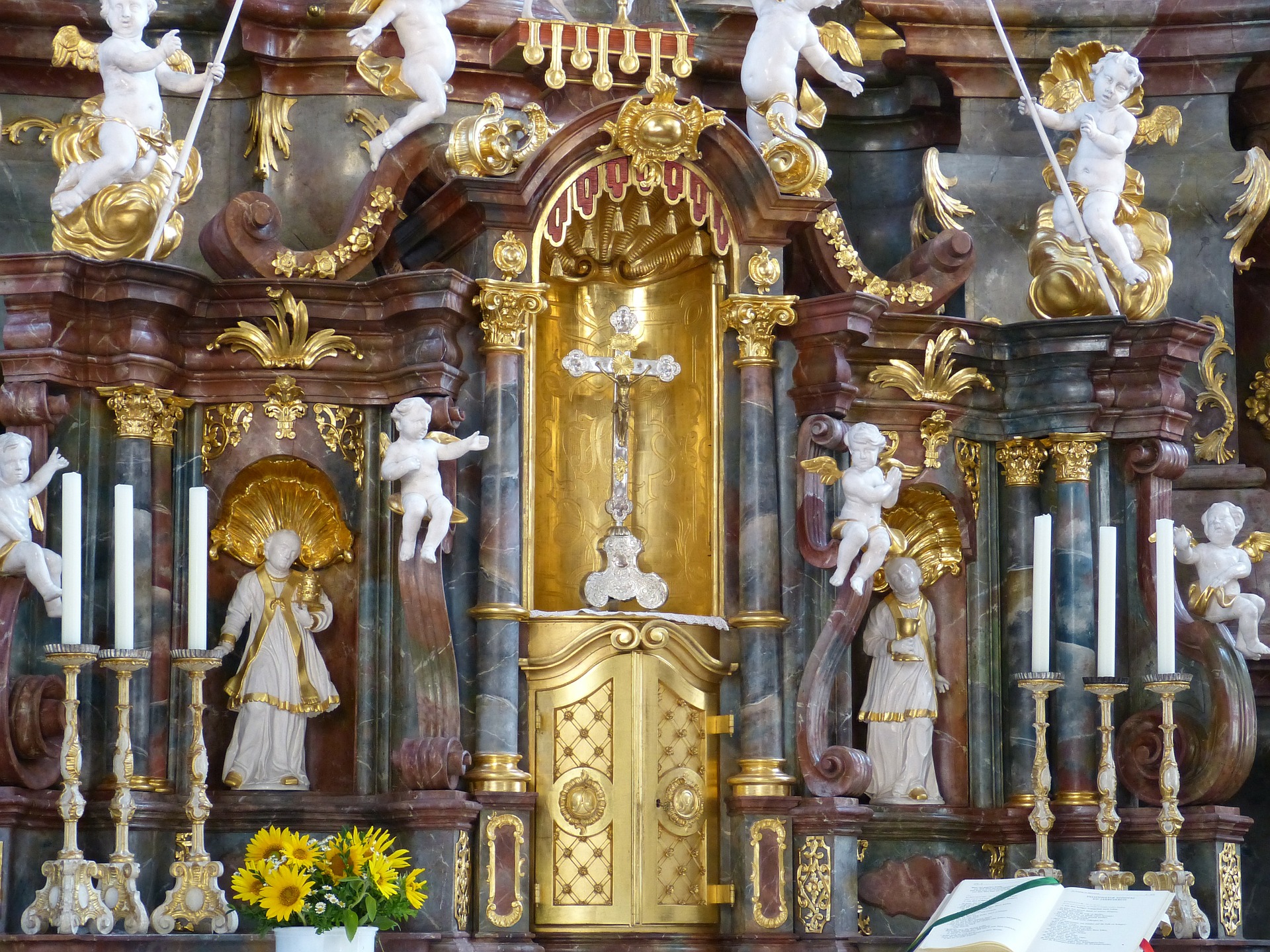Baroque Spirituality
TABLE OF TRANSFIGURATION
The Main Altarpiece was built by Cayetano de Acosta between the years 1770 and 1779.
In general, it develops its iconographic program in an ascending or vertical way. It begins with the tabernacle and continues with an Immaculate Conception, the Transfiguration of Jesus on Mount Tabor, accompanied by some of the Apostles, and ending with the figure of God the Father. All of this is surrounded by a large number of angels and archangels. This vertical sense of the work is accentuated by the triangular composition of the Transfiguration of Jesus and the scene of God the Father. It is only broken, horizontally, with the cornice located right where the golden capitals of the two pillars that frame the work meet.
The central part develops the main theme, the Transfiguration of Jesus on Mount Tabor. In the extreme left we can see Saint Peter who appears kneeling, and in profile. Next, and occupying the central area of this lower part of the composition, is San Juan, facing the viewer but with his gaze fixed on top. Finally, and on the far right, we have Santiago the Lesser, with his hands joined in an attitude of prayer.
Special interest shows the figure of Jesus on a cloud. It has considerable theatrical features. At his feet, on his knees, Moses, on the left, and the prophet Elijah, on the right.
On the vault of the presbytery, the Celestial Glory. It is painted by Juan de Espinal around 1775. This painting is a continuation of the main theme of the altarpiece; that is to say, the divine apotheosis, giving iconographic unity to all this space. One of its main features is the illusionism it creates before the viewer, since the composition is so realistic that it seems that the vision we have beyond the balustrade is completely real.
COVER-ALTARPIECE OF THE SACRAMENTAL CHAPEL
It is made by the Portuguese altarpiece and sculptor Cayetano de Acosta, between the years 1756 and 1764. It is a work with a high Eucharistic load due to the location it presents. The images of the Virgen del Voto and that of San José appear on the bench of the altarpiece.

The saints located on the sides of the door are San Francisco de Sales and San Felipe Neri. On both sides of this fence you can see 4 baroque angels. They are naked children with small, almost imperceptible wings. Among those on the left is the image of the Virgin of the Vow, an anonymous work from 1653. The Virgin is shown in a pensive attitude, with an absent gaze, after reading a devout book that she holds with her hands. On the right side you can see the image of Saint Joseph with the child in her arms, the work of the sculptor Blas Molner, made in 1781
In the upper part of the altarpiece there is a large tabernacle flanked by two large and beautiful angels. They have an androgynous face, an idealized beauty in the style of classical Greco-Roman sculptures. The treatment of their clothes is magnificent both on a decorative level, with a brilliant polychromy, as well as movement, with a multitude of folds of the cloths of their clothes and a messy hair.
But the central part is occupied by an allegory of the Eucharist, presenting characters from the Old and New Testaments, kneeling in an attitude of adoration. The set is finished off with a colossal God the Father.
BLESSED CHRIST OF LOVE
The Christ of Love can be considered one of the best crucified in the city. It is a masterpiece of Spanish Baroque sculpture and the most interesting carving of the sculptor Juan de Mesa y Velasco, dated 1620. It is of absolute anatomical perfection. It is an image so real, so natural, that when contemplating it, it is possible to erase the limits between illusion and reality. It makes the viewer forget, for a moment, that they are in front of a carved piece of wood and believe that they are really facing a man nailed to a cross.
That was precisely the goal of Baroque sacred art. The bony features of the face; the frown; the curved eyebrows, in the shape of a vee; eyes practically closed; swollen eyelids; sunken cheeks; deep dark circles … The face falls on the right side of his chest, Well, he just passed away. The half-open mouth reveals the upper teeth. The palms of the hands, each one pierced to the cross by a nail, remain open. The treatment of the cloth or shroud is perfect, a twisted cloth, with a multitude of folds enhancing light and shadow effects.
At the foot of the cross, a pelican with an open chest feeds her young, a symbol of infinite love for others.
CAMARÍN DE LA VIRGEN DE LAS AGUAS
The dressing room of the Virgen de las Aguas, built in the time of greatest devotion to the sacred image, is a kind of three rooms, being centered by the dressing room itself. It is a reduced space enabled to celebrate religious acts before the Virgin of the Waters, which is on a rotating panel that allows the carving to rotate and can be facing the interior of the Church or the interior of the dressing room.
Each of the three rooms has a high decorative interest, although in the first we can highlight the mural painting of the Presentation of the Virgin to Saint Ferdinand, and in the third, its oratory character. In the central one, a large quantity of plasterwork along with the scenes related to the life of the Virgin of her Birth, her Presentation and her Marriage.

